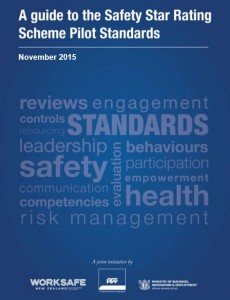The Safety Star Rating Scheme is now the Health and Safety Performance Improvement Toolkit. (Update: Now called SafePlus!). And it arrives Sept 2017. What is it, what’s it for?
Background
The Independent Task Force on Workplace Health & Safety reported in 2013. And they found there was no single critical factor causing New Zealand’s poor health and safety performance. Therefore, an improvement in health and safety performance a range of recommendations. And one recommendation was to create a voluntary health and safety rating scheme.
 The Pilot Scheme ran from November 2015 to June 2016. It was a joint project between Worksafe NZ, the Ministry of Business , Innovation and Employment (MBIE) and the Accident Compensation Corporation (ACC). 95 selected businesses gave assistance and an Expert Design Group also gave support and advice.
The Pilot Scheme ran from November 2015 to June 2016. It was a joint project between Worksafe NZ, the Ministry of Business , Innovation and Employment (MBIE) and the Accident Compensation Corporation (ACC). 95 selected businesses gave assistance and an Expert Design Group also gave support and advice.
To start with, government agencies talked about combining the Scheme with ACC’s incentive schemes. So some public information used the word “reward”. Now, the name “Safety Star Rating Scheme” (SSRS) is dropped. Furthermore, ACC discontinued their WSMP and WSD incentive schemes. So financial rewards for good health and safety performance had to move. Therefore, ACC are redirecting them to the Experience Rating System. (See this related post: Experience Rating. Does it work and can ACC improve it?)
Why is improved health and safety performance needed?
Compliance audits encourage businesses to do “minimum compliance”. So passing the audit – getting “ticks in boxes” – becomes the goal. Consequently, sustainable health and safety performance suffers.
The SSRS or Health and Safety Performance Improvement Toolkit approach is not all about compliance. So the focus will not be formal procedures or ticks in boxes. Instead, actual behaviours are the key, and people at all levels will need to show they understand and support the programme. For example, the aims, objectives and purposes of improved health and safety performance in the business. Also, information about health and safety must be accessible and understandable. In other words, assessors will want to know whether health and safety is built in to the organisational culture.
What does the health and safety performance toolkit look like?
The Toolkit was released as a pilot in November 2015 and it is now being revised following feedback. Here is the version used for the pilot study. This version had two “core concepts” and 15 “standards”. Now, it has 3 “core concepts” and 10 “performance requirements”. These are:
1. Leadership
- Effective health & safety governance.
 Demonstrate commitment.
Demonstrate commitment.- Continually improve.
- Resource health & safety.
2. Worker engagement
- Effective communication.
- Empower workers and representatives.
3. Risk management
- Identify risks.
- Assess risks.
- Control risks.
- Monitor control effectiveness.
There is also a concept of an underlying continuous improvement.
How will it work?
Detail is still being finished. But resource materials, guidance and independent on-site assessments will be first. And the target for free online self-assessments is mid 2018. The recruitment and training of independent assessors has already started.
The business arranges on-site assessments directly with the assessor. Due to the nature of the assessment, the focus is on People, Resources, Behaviours, Systems, Practices, Attitudes and Culture. Notice how that list is about intangibles, and you can’t create pieces of paper for it. So it’s about words, values, actions and behaviour. And that’s the point, because health and safety performance is largely a behavioural matter. Therefore, the difference is made by people, attitudes and culture. But ticks in boxes do not make people and their behaviour safe.
There are three levels of achievement: 1. Developing (not yet meeting the standard); 2. Performing (health and safety performance is reviewed and monitored. So workers will be engaged. Risks identified and actions will be taken); 3. Leading (health and safety performance is integral. So, a sense of ownership. Or the business takes a leading industry role in health and safety performance improvements). In addition to the assessment covering the 10 performance requirements, there is a “deep-dive”. The assessor will look through the layers of the organisation with regard to at least 3 key health and safety risks.
The three levels of achievement could be seen as similar to ACC’s Primary, Secondary and Tertiary, at least as a concept of progress and excellence. But the scheme does not replace WSMP/WSD and there are no financial rewards attached.
 How will an assessment will be carried out?
How will an assessment will be carried out?
We don’t know the detail yet, but pieces of paper will only play a supporting role. So the assessor will interview individuals and groups and determine how much they understand; how information is presented; available support and resources; what actually happens; that activities and beliefs are part of “the way things are done around here”. Therefore, they will not take anything on face value. And unlike previous audits, such as ACC’s, the assessor will have a value added duty to provide advice and guidance.
These are some examples from the Pilot Scheme requirements:
- 1.2 Senior leaders prioritise OHS actions as a result of the business’s risk profile. Conclusion:This includes officers and senior managers. It would require a risk profile and an understanding of the business. Also, the meaning of risk and a set of agreed actions to reduce risk. Finally, a prioritisation method and evidence of actions being taken.
- 2.4 Everyone in the business understands and engages with the OHS vision. Conclusion: This is an example of something where a piece of paper just won’t cut it. The assessor will ask open questions to real people. Expected answers won’t be yes or no.
- 3.3 Everyone is competent to perform their role. Conclusion: That will lead to some interesting assessments! Assessors will need some good skills. Imagine making those recommendations!
- 14.1 The business reviews the effectiveness of risk management activity. Conclusion: The guidance notes say that questions could include: Changes in the risk profile. Improvements needed. Reports/feedback from workers. Learnings from recorded data. Guidance from regulatory bodies.
The above is a small selection. Many of the requirements can only be assessed using qualitative judgements. For example, performance, competence and understanding.
The Worksafe website rightly says: “The health and safety performance improvement assessment is not a traditional conformance product“.
Intended benefits
The organisers expect these benefits as a result of participation in the scheme:
- Independent assurance and increased confidence in managing health and safety.
- Reduced costs and inefficiencies caused by workplace injuries.
- Access to continuous improvement by providing accessible guidance and advice.
- Support for bidding in contracts where health and safety is an important factor.
- Enhanced reputation and brand recognition.
- Showing leadership and commitment to employee welfare.
More details as information comes to hand.
Email us or call Simon Lawrence +64 9 535 4355 or 0800 000 267 if you would like to chew over:
- Health and safety software system SafetyBase.
- More information on the Health and Safety Performance Improvement Toolkit.
- Safety systems that support the HSW Act and ACC requirements.
- Assistance assessing your level of conformance.
- Health & Safety training for your people

